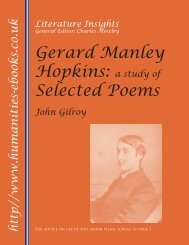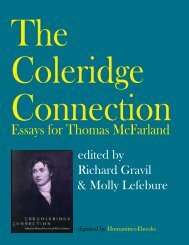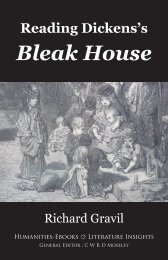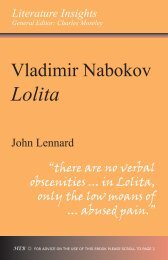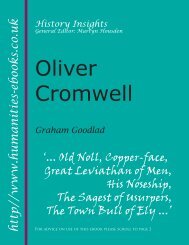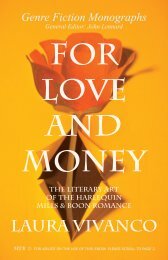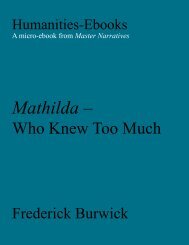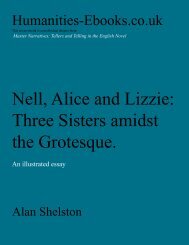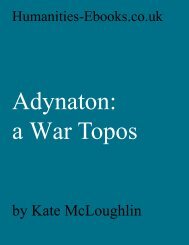The Achievement of E M Forster ISBN 978-1-84760-003-5
The Achievement of E M Forster ISBN 978-1-84760-003-5
The Achievement of E M Forster ISBN 978-1-84760-003-5
Create successful ePaper yourself
Turn your PDF publications into a flip-book with our unique Google optimized e-Paper software.
Running Head <br />
<strong>The</strong><br />
<strong>Achievement</strong><br />
<strong>of</strong><br />
E. M. <strong>Forster</strong><br />
by John Beer<br />
digitized by Humanities-Ebooks
Publication Data<br />
© John Beer, 1962, 2007<br />
<strong>The</strong> Author has asserted his right to be identified as the author <strong>of</strong> this Work<br />
in accordance with the Copyright, Designs and Patents Act 1988.<br />
First published in 1962 by Chatto & Windus<br />
This edition published in 2007 by Humanities-Ebooks LLP<br />
Tirril Hall, Tirril, Penrith CA10 2JE<br />
Reading Options<br />
* To use the navigation tools, the search facility, and other features <strong>of</strong> the<br />
Adobe toolbar, this Ebook should be read in default view.<br />
* To navigate through the contents use the hyperlinked ‘Bookmarks’ at<br />
the left <strong>of</strong> the screen.<br />
* To search, expand the search column at the right <strong>of</strong> the screen or click<br />
on the binocular symbol in the toolbar.<br />
* For ease <strong>of</strong> reading, use to enlarge the page to full screen<br />
* Use to return to the full menu.<br />
* Hyperlinks appear in Blue Underlined Text.<br />
Licence and permissions<br />
This book is licensed for a particular computer or computers. <strong>The</strong> file itself<br />
may be copied, but the copy will not open until the new user obtains a licence<br />
from the Humanities-Ebooks website in the usual manner. <strong>The</strong> original purchaser<br />
may license the same work for a second computer by applying to<br />
support@humanities-ebooks.co.uk with pro<strong>of</strong> <strong>of</strong> purchase. Permissions: it<br />
is permissible to print sections <strong>of</strong> the book (in draft mode) for your own use,<br />
but not to copy and paste text.<br />
<strong>ISBN</strong> <strong>978</strong>-1-<strong>84760</strong>-<strong>003</strong>-5
Contents<br />
Chapter 1<br />
Aspects <strong>of</strong> a Novelist<br />
Chapter 2<br />
<strong>The</strong> Earth and the Stars<br />
Chapter 3<br />
From a View to a Death<br />
Chapter 4<br />
Flame Boats on a Stream<br />
Chapter 5<br />
In Country Sleep<br />
Chapter 6<br />
<strong>The</strong> Undying Worm<br />
Chapter 7<br />
Serving the World<br />
Chapter 8<br />
In and out <strong>of</strong> Time<br />
Bibliography and Abbreviations
Chapter 1<br />
Aspects <strong>of</strong> a Novelist<br />
THE account <strong>of</strong> E. M. <strong>Forster</strong> which has reached more readers than any other<br />
appears on the cover <strong>of</strong> a paper-back edition <strong>of</strong> his works:<br />
He is one <strong>of</strong> those rare authors whose books are kept and re-read, not only for their<br />
stories, but for the wise sayings which crowd their pages and the gentle humanist<br />
philosophy which they reveal.<br />
A general comment like this, addressed as it is to the reader who likes a good story,<br />
seasoned with occasional wisdom, might be allowed to stand. It is more disquieting<br />
to find the author <strong>of</strong> the Concise Cambridge History <strong>of</strong> English Literature, which<br />
ought to have a different audience in view, writing <strong>of</strong> the ‘shy, unworldly quality’ <strong>of</strong><br />
work ‘almost diffidently presented’ by a man who is ‘at heart a scholar’. As Lionel<br />
Trilling points out, the author <strong>of</strong> such a comment has taken an irony literally and has<br />
misinterpreted a manner. <br />
One reason for the diverging views <strong>of</strong> critics in dealing with <strong>Forster</strong>’s work is a<br />
basic uncertainty as to how the novels ought to be read. <strong>The</strong>re is a deceptive directness<br />
about them—a concentration on events, which encourages the reader to read them<br />
‘for the story’.<br />
<strong>Forster</strong> himself has never forgotten the truth which he reiterated painstakingly in<br />
his Clark Lectures: ‘Yes—oh dear yes—the novel tells a story.’ Yet it would be foolish<br />
to see in this statement more than a basis on which to build. For example, there is<br />
a good deal <strong>of</strong> attention to plot in the novels: but it is evidently not aimed at creating<br />
(In the case <strong>of</strong> <strong>Forster</strong>’s novels, the page reference is to the pocket edition but the text is normally<br />
taken from the first edition. A list <strong>of</strong> abbreviations appears in the Bibliography.)<br />
G. Sampson, <strong>The</strong> Concise Cambridge History <strong>of</strong> English Literature 1941, p.969<br />
L. Trilling, E. M. <strong>Forster</strong>, London, 1944, p. 9.<br />
AN, 40-1; 62.



